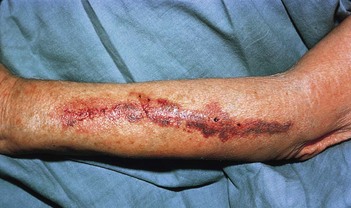151 Purpura
Salient features
Examination
• Small circumscribed bleeding into the skin, purpura, or larger lesions, bruises or ecchymoses (Fig. 151.1). Lesions begin as 1–3 mm papules, which increase in size and become palpable. They may coalesce to form plaques; in some instances, they may ulcerate.
• Look for an underlying cause
• Comment on the patient’s age: consider senile purpura
• Comment on the distribution: Henoch-Schönlein purpura is seen over the buttocks and lower limbs (p. 566)
• Look for the following signs:
• Tell the examiner that you would like toexamine spleen, liver and lymph nodes.
Questions
What are causes of bruising?
• Thrombocytopenia: idiopathic thrombocytopenic purpura, marrow replacement by leukaemia or secondary infiltration
• Vascular defects: senile purpura, steroid-induced purpura, Henoch–Schönlein purpura, scurvy, von Willebrand’s disease, uraemia
• Coagulation defects: haemophilia, anticoagulants, Christmas disease
• Drugs: thiazides, sulphonamides, phenylbutazone, sulphonylureas, sulindac, barbiturates.







